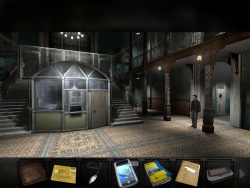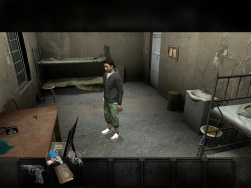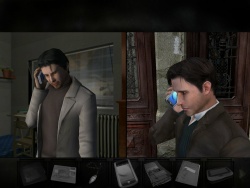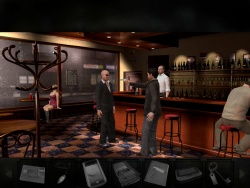|
Overclocked: A History of Violence
 Overclocked
– past participle of the verb "to overclock" – the process of forcing a computer to run at a faster clock rate
than originally designated. Can lead to overheating and system instability. Overclocked
– past participle of the verb "to overclock" – the process of forcing a computer to run at a faster clock rate
than originally designated. Can lead to overheating and system instability.
Much like David McNamara, former forensic psychiatrist for the U.S. Army, called in to unravel why 5 young strangers
were found wandering the streets of New York screaming, without memory, and exhibiting violent behaviour.
The question is, who will unravel first?
You can feel the tension in David as he goes about his task. He has a past, and violence dwells therein. His
present is not that relaxed either. Things aren't going well in his marriage, and his professional reputation
seems a little shaky.
Whilst the main storyline in Overclocked is the why and the what of the 5 youths, I confess I found
the undercurrent of David McNamara more intriguing. Overwound, overwrought, overwhelmed; he was either going to
explode or meltdown. He seemed permanently on the edge of both, and I sympathised with him without knowing why.
So I followed him around as he began speaking to the patients, now housed at a Staten Island psychiatric facility.
I was interested in their story, but intrigued by what would happen to David.
 Overclocked
is third person point and click. You play David for the most part, and the bulk of what goes
on involves unpicking the memories of the 5 strangers, and putting them back together. It is quickly apparent that
there is a connection, and weaving the threads together to discern the pattern is the challenge for David. Overclocked
is third person point and click. You play David for the most part, and the bulk of what goes
on involves unpicking the memories of the 5 strangers, and putting them back together. It is quickly apparent that
there is a connection, and weaving the threads together to discern the pattern is the challenge for David.
The methodology involves finding the trigger that will get the particular patient to tell you a little more. David
records all of his sessions, and playing the correct portion to another person will be the key to them telling you
something new. What you learn will then enable you to get a little more out of someone else.
It's interesting at first, especially as what you learn is coming from 5 separate perspectives and is not in
orderly sequence. You get bits and pieces from different timeframes, and juggling and ordering the pieces adds an
extra dimension.
But I confess that after a while it was all a bit the same, and by the end it was a little tedious. Record a session,
play the right bit to someone else, record that session, play another bit to someone else, record that session and so
on and so on. There is a lot of it, and whilst it's punctuated by other things, I did think it suffered by being, well,
overdone.
It is though very well presented. You get to play as the particular patient whilst they are telling their story,
and the use of split screens, black and white imagery, and cinematic quality cutscenes all make for a rich game canvass.
The scenes look good, voice acting is excellent, and the musical score gets under your skin, ensuring the mood remains
taught and brooding throughout.
 Then there's the rain. It never stops, the proverbial storm that has gathered over David. Things are only complete
when the storm breaks, literally and figuratively. Then there's the rain. It never stops, the proverbial storm that has gathered over David. Things are only complete
when the storm breaks, literally and figuratively.
The conundrums are primarily inventory based, with a few outright puzzles along the way. Number codes predominantly,
none terribly difficult if you pay attention. The conundrums offer a bit more of a challenge, and are relatively self
contained. Like all such games, finding the items you need is often the sticking point – along with not knowing what
it is you need.
It's not a terribly open game, meaning you have limited things to do and a limited environment in which to do them
before you can move on. Each patient also has very little in the way of inventory belongings, and so solving their
conundrums are generally easier than solving David's.
Clicking on an item you can interact with will cause a number of animated icons to appear. Perhaps a magnifying glass,
a grasping hand, an opening door. Click the icon you want to perform that action. Exits from the scene are utilised in
the same way, and double clicking an exit will jump you to the nest scene, albeit after a short load.
Speaking of which, make sure you load a file called resource.200 from one of the two DVDs into the game
folder. Why the game doesn't do this automatically is beyond me. It will spare you from interminably lengthy loads before
a cutscene plays. And if you have an ATI graphics card, you might need to download a patch to then see the cutscenes.
 There are one or two scenes in Overclocked that some may find confronting, and one that made me jump. You can't
die, either as David or one of the patients. There are no sliders, mazes or musical puzzles. There are one or two scenes in Overclocked that some may find confronting, and one that made me jump. You can't
die, either as David or one of the patients. There are no sliders, mazes or musical puzzles.
David's PDA will be your gadget of choice. He records his sessions on here, and every part can be reviewed. He receives
e-mails and makes telephone calls, although he may make you go elsewhere before he will phone.
I won't tell you anything about what occurred to the 5 young patients, as finding that out is what Overclocked
is about. Violence though is at its heart, as the name suggests. And a little violence begets a little more, as David knows
too well.
Nor will I divulge what happens to David, although I will say that the game should definitely have finished one scene
sooner. Take my advice – stop watching after the monologue during which you examine David's soul through his own eye. What
comes after is inexplicable in the context of the game and an unworthy punctuation.
Overclocked was different to a lot of games, and its makers are developing a pedigree in that regard
(Mystery of the Druids, The Moment of Silence).
Its atmosphere may be a little oppressive for some, but if a bit of psycho-drama is your thing, and you aren't averse to
some doom and gloom, this a generally well told and nicely put together tale.
Copyright © Steve Ramsey 2008.
All rights reserved.
System Requirements:
Microsoft Windows ME/2000/XP/Vista, 1.3 Ghz Intel Pentium or AMD Athlon processor (2.0 Ghz recommended),
512 MB RAM for XP (1 GB recommended, 1GB minimum for running Vista), 4x CD-ROM/DVD-ROM drive,
5.0 GB free hard disk space, DirectX 9 compliant video card Shader Model 1.1 (Shader Model 2.0 support recommended),
DirectX 9 Compliant Sound Card
|

